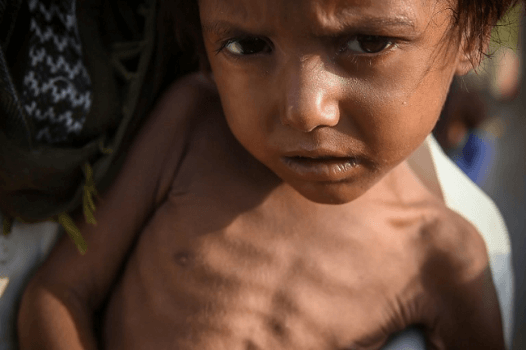Malnutrition DefinitionWhen an organism receives too few or too many nutrients, it can lead to malnutrition or nutritional deficiency, which can have negative health effects. In particular, the tissues and shape of the body are negatively impacted by "a deficit, excess, or unbalance of energy, protein, and other nutrients." Not getting enough nutrients results in malnutrition. Kids below the age of five are becoming more malnourished due to carers who can't afford to feed them properly or don't have access to it. Undernutrition and overnutrition are both included in the disease category known as malnutrition. Lack of nutrients causes undernutrition, which can cause underweight, wasting, and stunted growth. A surplus of nutrients causes' overnutrition, which can result in obesity. Communities in some undernourished developing countries are now showing signs of overnutrition in the form of obesity. 
The term "malnutrition" is typically used in clinical investigations to describe undernutrition. It is hard to differentiate between the two when 'malnutrition' is used instead of "undernutrition," causing overnutrition, a less well-known type of malnutrition, a more dangerous condition. On account of this, 'The Lancet Commission' suggested in a 2019 study that the definition of "malnutrition" be broadened to include "all its forms, especially obesity, undernutrition, & associated dietary risks." The World Health Organization" and Lancet Commission have also drawn attention to the double burden of malnutrition, which is caused by "the coexistence of overnutrition (overweight & obesity) with undernutrition (stunted growth & wasting). PervasivenessAccording to estimates, one in three people worldwide suffers from one or more types of malnutrition, including wasting, stunting, vitamin or mineral deficiencies, overweight, obesity, or noncommunicable diseases linked to diet. In developing countries, undernutrition is more common. Urban slums have a higher prevalence of stunting than rural areas. According to studies on malnutrition, the population is divided into several categories, including new-borns, children under the age of five, kids, teens, pregnant women, adults, and the elderly. The prevalence of undernutrition reported in various studies varies due to the use of various growth references in various investigations. Charts of economic growth from the 'National Center for Health Statistics' (NCHS), the WHO reference from 2007, growth statistics from the 'Centres for Disease Prevention and Control' (CDC), and the National Health & Nutrition Survey (NHANES), the WHO reference from 1995, the Obesity Task Force (IOTF) criteria, and the Indian Academy of Paediatrics (IAP) growth charts are a few examples of the growth references used in studies. Effects in ChildrenThe rates of undernutrition among children under five are the highest. In 2020, there were 149 million stunted children under the age of five, 45 million wasting children, and 38.9 million overweight or obese children. The next year, undernutrition was thought to be a contributing factor in 45% of child fatalities. According to estimates, 16% of South Asian children under the age of five are either highly or severely wasted. Asia's largest producer of garbage is India, which has about 20% of its kids squandered. But in countries in Africa, undernutrition is much more common among kids under the age of five. A pooled research revealed that the prevalence of chronic undernutrition amongst several children under the age of 5 in East Africa was 33.3%. Between Kenya and Burundi, the frequency of undernutrition among children mal five varied from 21.9% to 53.0%. Under-five stunting rates in Tanzania ranged from 41% in lowland areas to 64.5% in highland areas. Tanzania had undernutrition rates of 11.5%, 2.5%, and 22.0%, respectively, in the lowland and highland regions. In South Sudan, stunting, being underweight, and wasting in children under the age of five predominated, with the respective prevalence of 23.8%, 4.8%, and 2.3%. Insufficient vitamin A causes 670,000 fatalities and between 250,000 and 500,000 incidences of blindness worldwide, affecting one-third of young children under the age of five in grownups. Effects in Adults462 million adults were underweight as of June 2021, and 1.9 billion adults were overweight or obese. In 2017, there were two billion iodine-deficient cases worldwide. 900 million women & children experienced anaemia in 2020, which is frequently brought on by iron deficiency. Certain demographics, such as the elderly and women, have greater rates of undernutrition (in particular while pregnant and breastfeeding children under 5 years of age). Even in affluent nations, undernutrition is a growing health issue for adults over 65, particularly for those who dwell in acute care hospitals and nursing homes. In the elderly, physical, psychological, & social factors?rather than a lack of food?are more frequently to blame for undernutrition. Major causes of undernutrition in the older population include age-related reduced nutritional intake brought on by chewing and swallowing issues, sensory deterioration, depression, unbalanced gut flora, poverty, and loneliness. Recent growth in casesOver the past ten years, hunger and food insecurity have increased globally. 795 million people, or nearly one among 10 people on the planet, were undernourished in 2015. In 2020, 820 million people, or one in nine people, were undernourished. Globally, 1.3 billion people were predicted to experience food insecurity in 2022. The ongoing COVID-19 epidemic, which continues to draw attention to the flaws in the present food and healthcare systems, is partly responsible for these increases. Worldwide hunger has increased due to it, and the reduction in physical activity that resulted from lockdowns has also contributed to a rise in overweight and obesity. Also, according to experts, COVID-19 may cause a rise of 14% in the occurrence of severe and moderate malnutrition. This, along with a loss in access to nutrition & healthcare services, led to over 128,000 more deaths of kids under the age of 5 in just 2020. Although COVID-19 affects children less severely than it affects adults, undernutrition raises the likelihood of developing a serious illness. Man-made wars, climatic shifts, and economic downturns are more significant causes of famine. DefinitionsUndernutritionUndernutrition can be brought on by micronutrient deficiencies or protein-energy waste. It affects both mental and physical well-being negatively, changes body composition, and decreases body cell mass. Children under the age of five are particularly at risk of dying from undernutrition, which also has long-lasting physiological effects. It prevents kids from fully developing physically and mentally. Being Underweight, wasting, and stunting are all signs of undernutrition. Undernutrition can cause long-term issues with mental and physical growth if it happens during pregnancy or before the age of two. Starvation, chronic starvation, severe acute malnutrition (SAM), or mild acute malnutrition (MAM) can all result from severe undernutrition. The micronutrient that is deficient will determine the indications and symptoms. However, undernourished persons frequently have low energy levels, are slender and small, and frequently have swollen legs and tummies. People who are malnourished typically get diseases and frequently become chilly. 
Micronutrient deficiencyInsufficient vitamin and mineral consumption lead to micronutrient deficiency. Iron, vitamin A, and iodine deficits are the most prevalent globally. Low-income countries have a particularly high risk of micronutrient deficiencies in children and pregnant women. An iron shortage most frequently brings on anaemia; however, it can also be brought on by other disorders and micronutrient deficiencies. There may be serious health repercussions from this syndrome. The coexistence of micronutrient deficiencies and overnutrition is referred to as the double burden of malnutrition phenomenon. Energy-protein malnutritionProtein-energy deficiency is also specifically referred to as "PEM undernutrition". Micronutrient deficits, as well as an unbalanced protein intake & energy expenditure, contribute to this disease. The difference between it and calorie restriction is that calorie restriction might not have a negative impact on health. Hypoalimentation (underfeeding) is one of the causes of malnutrition. Kwashiorkor and marasmus are two types of PEM that frequently coexist. Symptoms of kwashiorkor, a lack of protein in the diet, in a child. The main contributor to kwashiorkor is a lack of protein consumption. Edema, wasting, enlarged liver, hypoalbuminemia, and steatosis are some of its signs; the illness may also result in depigmentation of the skin and hair. The illness can also be recognized by the patient's characteristically swollen extremities and tummy, which hides their undernutrition. The term "Kwashiorkor" is a derivative of the Ga language spoken in coastal Ghana, West Africa, and means "displaced child." When the older child is transitioned to a diet high in carbs after being denied breastfeeding, it commonly results in the sickness that baby experiences after the subsequent kid is born, as it often does. A portion size that is continuously low in protein and energy might result in marasmus, which is defined as "to waste away". Their metabolism changes as a result to extend their survival. The chief symptoms include severe wastage with little to no edema, low subcutaneous fat, and abnormal serum albumin levels. It is typically observed in situations of hunger, severe food restriction, or extreme anorexia. Conditions are distinguished by severe muscle wasting and a haggard appearance. OvernutritionOvereating is a condition brought on by excessive consumption of energizing foods and beverages and insufficient exercise. It contributes to obesity and creates overweight, which is indicated by a body mass index (BMI) around 25 or above (a BMI of 30 or more). Globally, obesity has emerged as a serious health concern. Diabetes, certain malignancies, and cardiovascular diseases are examples of chronic non-communicable diseases that are associated with overeating. Hence it has become a top health priority to identify and address the primary risk factors. The results of several generations' health are negatively programmed, according to current research on the effects of diet-induced obesity in mothers and fathers around the point of conception. EffectsAll immune system components become more vulnerable to malnutrition. The susceptibility to infection is increased by protein and energy deprivation, as well as by deficits of particular micronutrients (including iron, zinc, and vitamins). These extra health hazards pose a serious issue in locations or populations without access to clean drinking water. Malnutrition plays a significant role in the emergence of active TB. Moreover, it raises the possibility of HIV transfer from mother to child and HIV replication. Malnutrition can result in the vitamin-deficient diseases rickets and scurvy. Those who are malnourished report decreased energy and mental function as the condition develops. As a result, they can find it difficult (or impossible) to complete the tasks necessary to obtain food, money, or an education. 
Acute issues like hypoglycaemia (low blood sugar) can also be brought on by malnutrition. Lethargy, limpness, convulsions, and loss of consciousness can all be symptoms of this illness. Most vulnerable are children, who might develop hypoglycaemia after about four to six hours without meals. Dehydration can also be life-threatening in those who are undernourished, especially in infants and young children. Risk elementSevere malnutrition in a child Social factors significantly impact people's health. The key socioeconomic factors of undernutrition are lack of women's empowerment, poor education, poverty, and illness burden. Undernutrition can be permanently eliminated by identifying and treating these variables. As a serious public health issue, research has focused heavily on identifying the socioeconomic factors that contribute to malnutrition in young children under the age of five. A lack of availability of good meals causes undernutrition. The likelihood of undernutrition & overnutrition in a community is influenced by household income, a socioeconomic factor. According to the analysis by Ghattas (2020), households with higher incomes are far more likely to have overnutrition than families with lower incomes. One of the main obstacles limiting low-income households from purchasing nourishing meals is high food prices. For instance, Khan and Kraemer (2009) discovered that in Bangladesh, chronic malnutrition was linked to a poor socioeconomic position because it prevented the purchasing of nourishing meals (like milk, meat, poultry, & fruits). Malnutrition may also be a result of food shortages in less technologically advanced nations. The Food and Agricultural Organization (FAO) believes that in the developing world, 80 percent of starving children reside in nations with food surpluses. Although there has always been sufficient food for everyone on the planet, economist Amartya Sen claims that in recent years, hunger has always been a problem with food distribution, wealth, and/or poverty. There are also socioeconomic reasons for malnutrition. People might be more at risk of becoming malnourished in a community with a weak government & insufficient medical facilities, for example. On a smaller scale, differences in money, land ownership, or educational status may put certain families or individuals in even greater danger. Community is crucial for addressing the socioeconomic causes of malnutrition. For example, communities with powerful social support and knowledge sharing about social protection programmes might make better public service demands. These areas have enhanced public service needs and social protection efforts, which reduce the likelihood of malnutrition occurring. There is a claim that traders in commodities are driving up food prices. According to reports, trillions of dollars migrated to invest in food and basic commodities as the American real estate bubble burst, resulting in the food price crisis of 2007-2008.
Next TopicManagerial Economics Definition
|
 For Videos Join Our Youtube Channel: Join Now
For Videos Join Our Youtube Channel: Join Now
Feedback
- Send your Feedback to [email protected]
Help Others, Please Share









